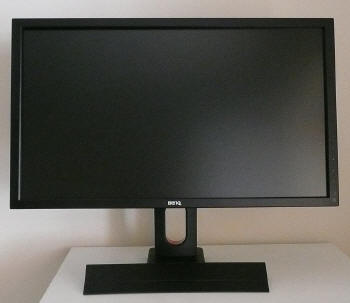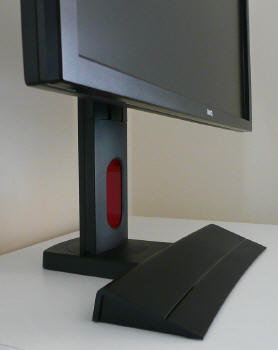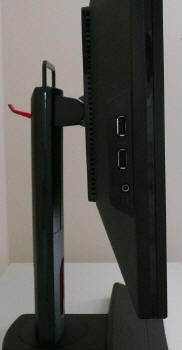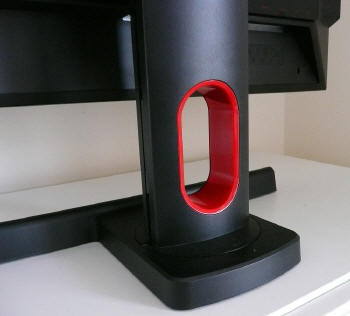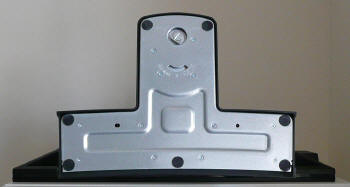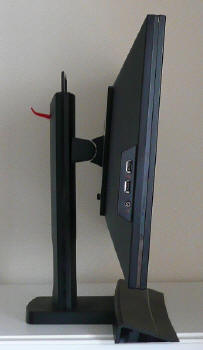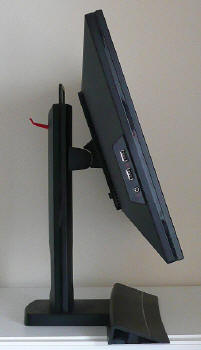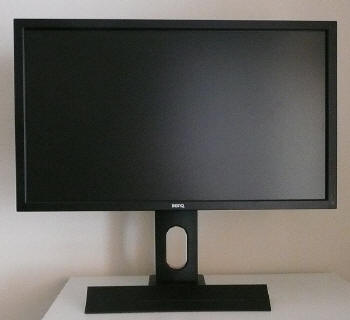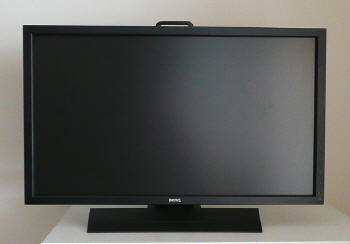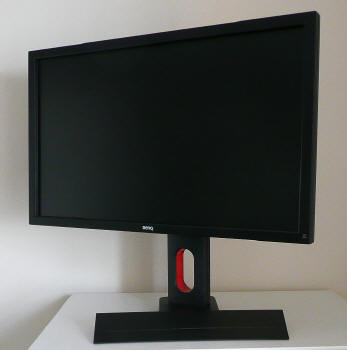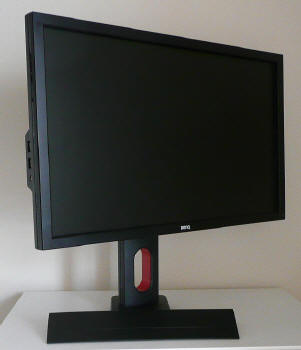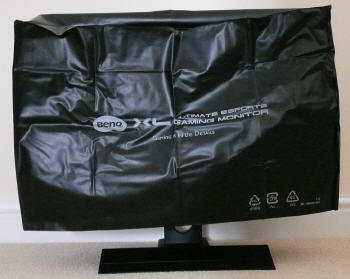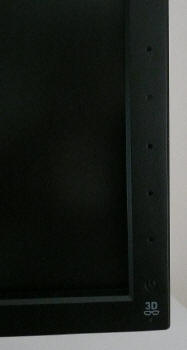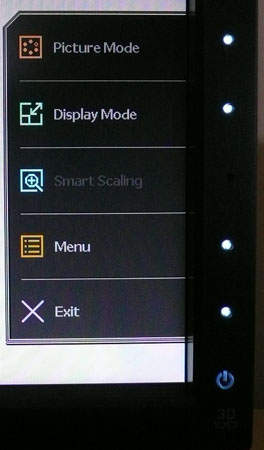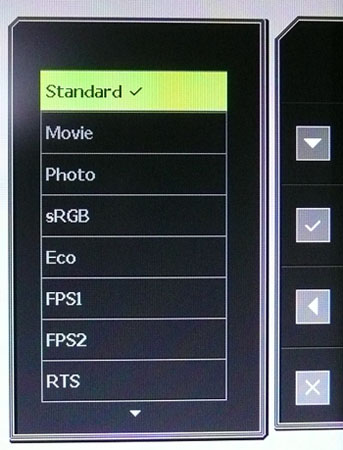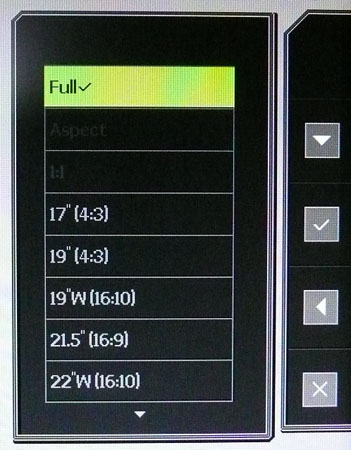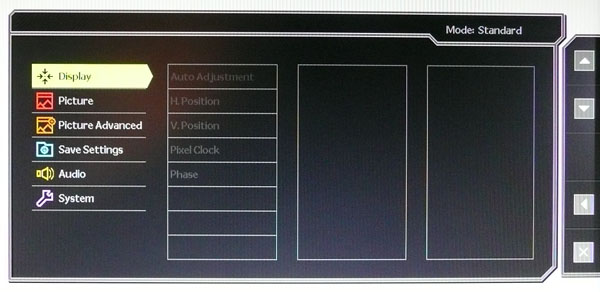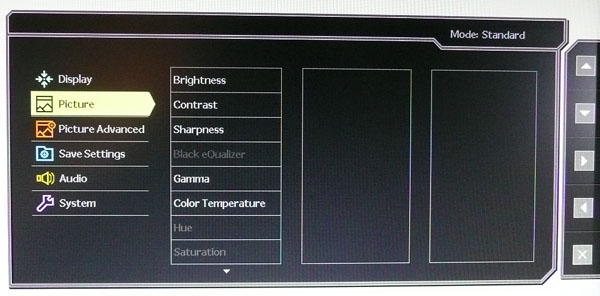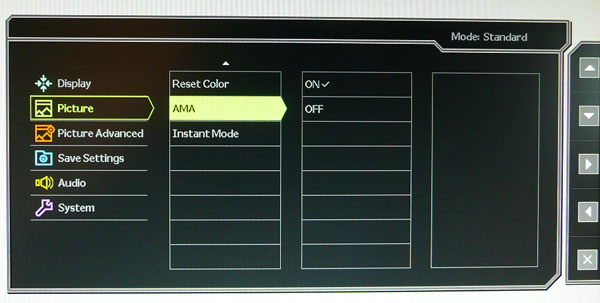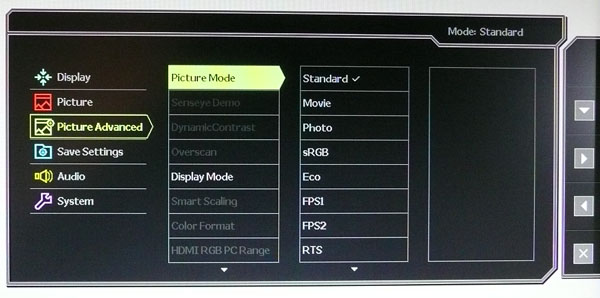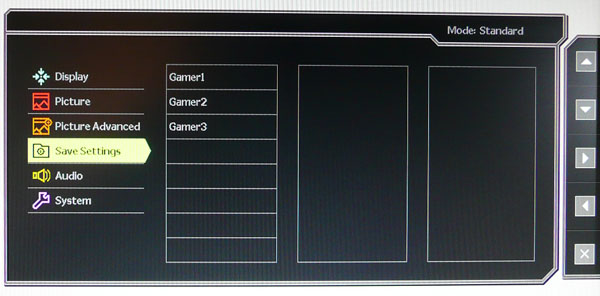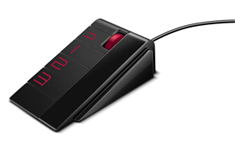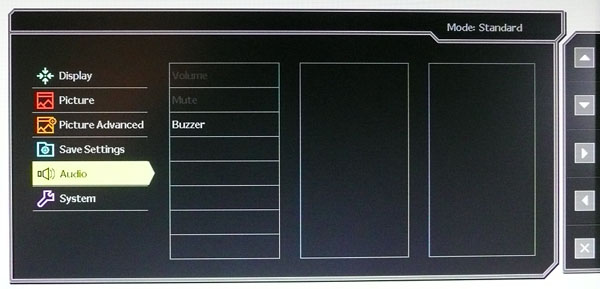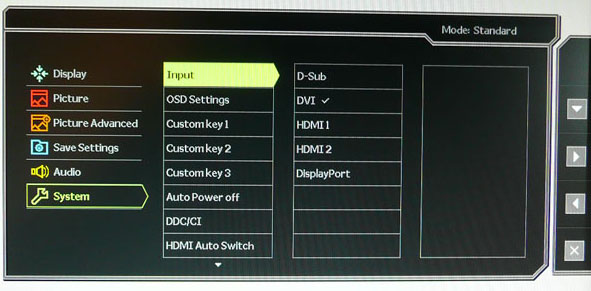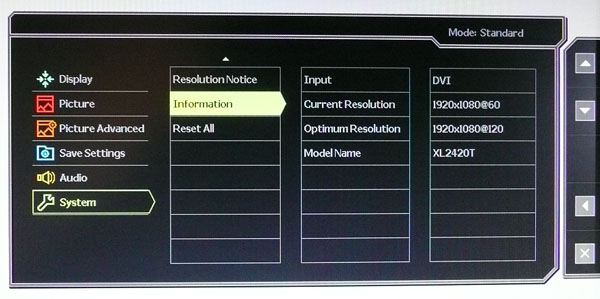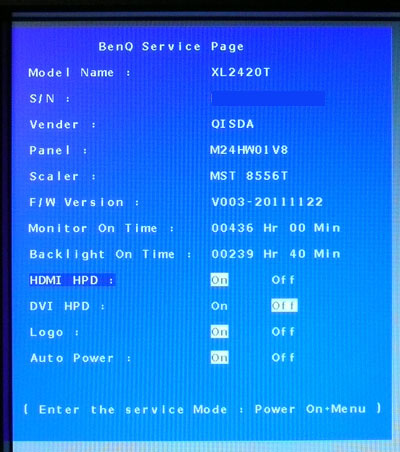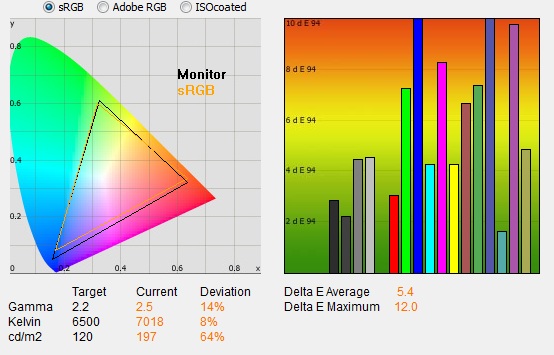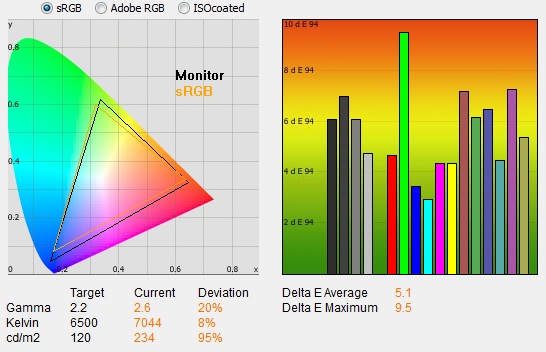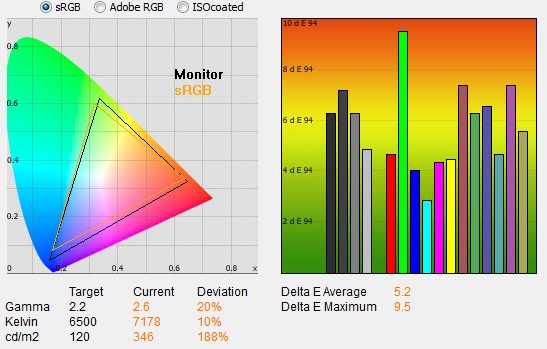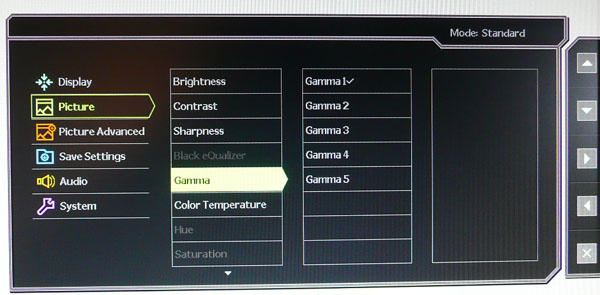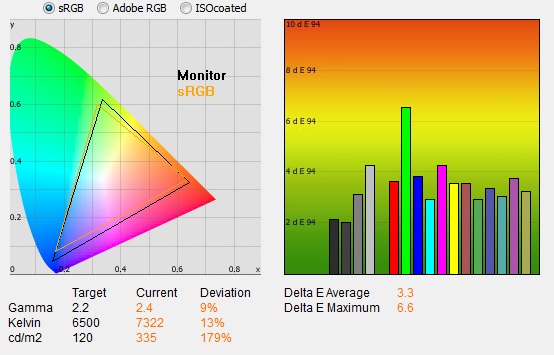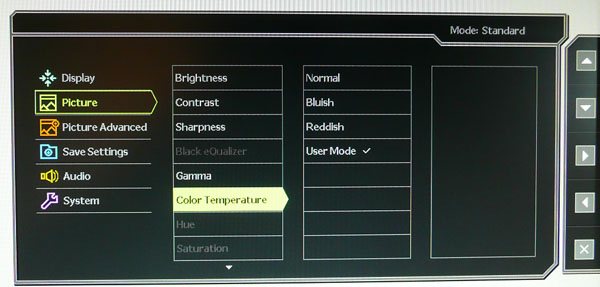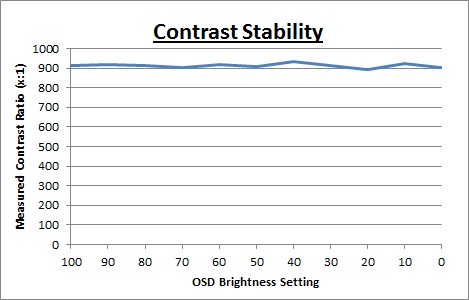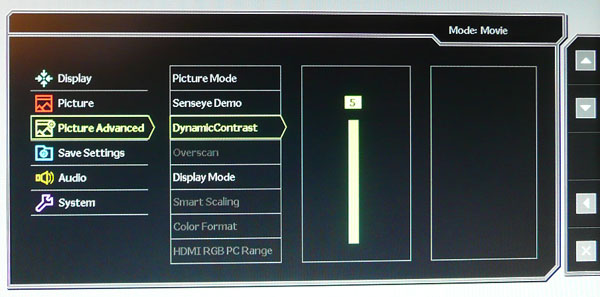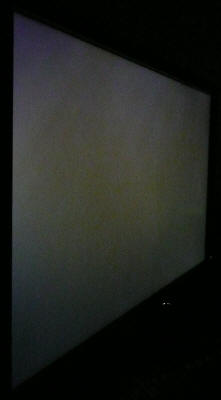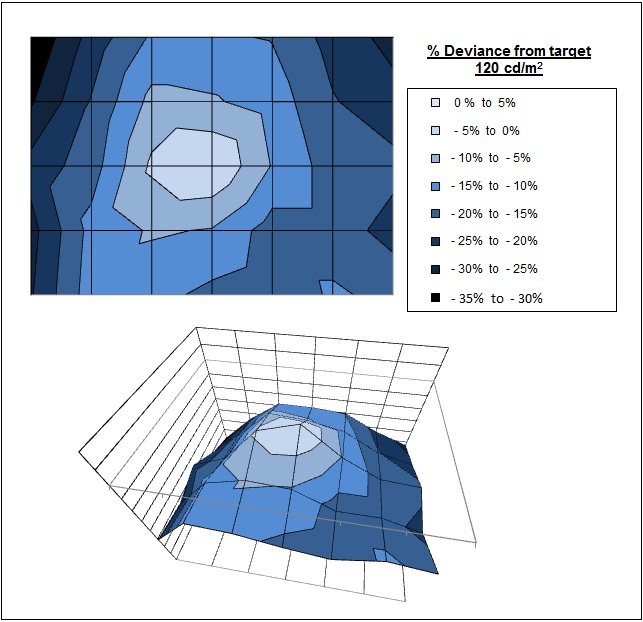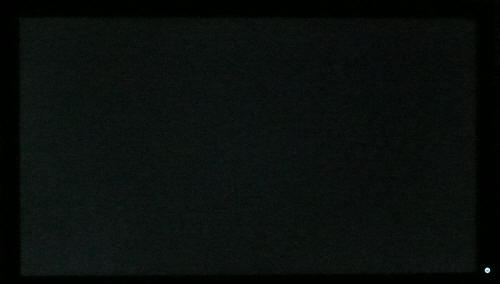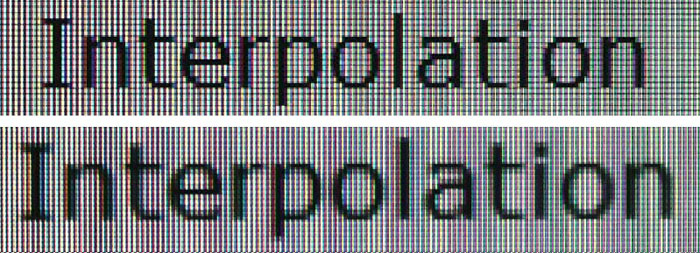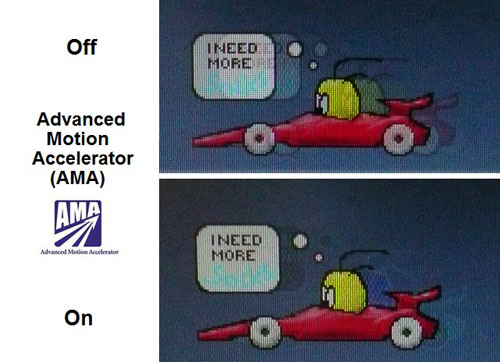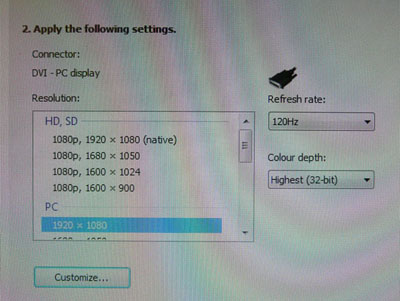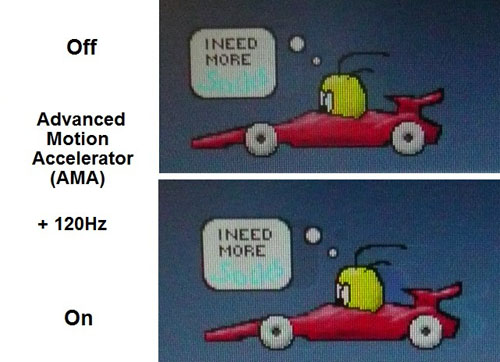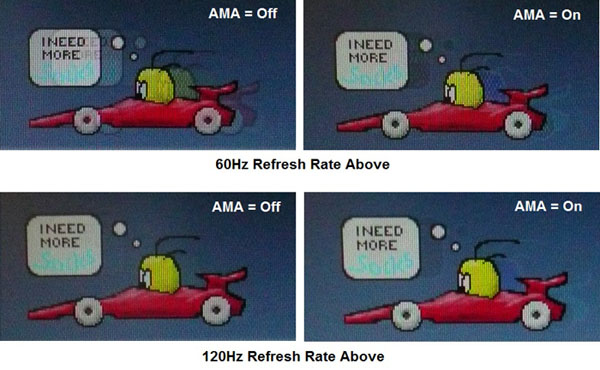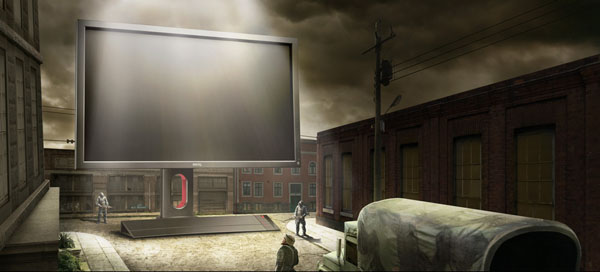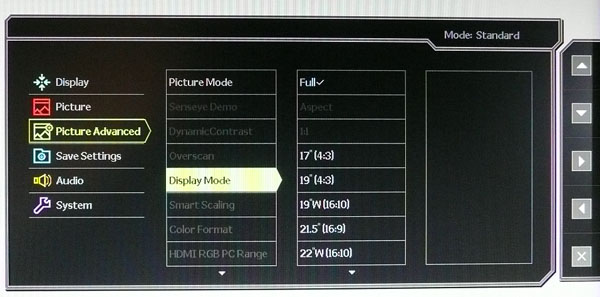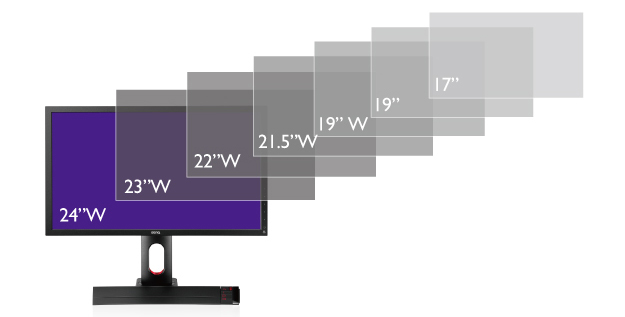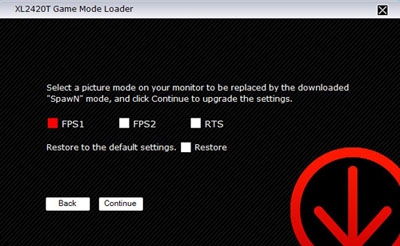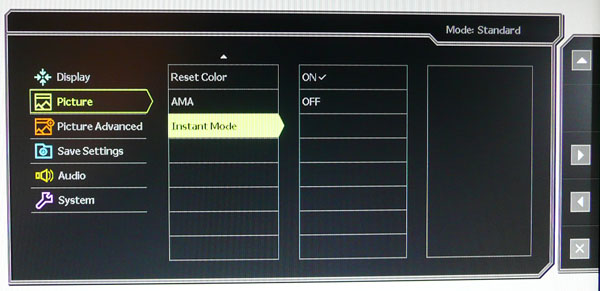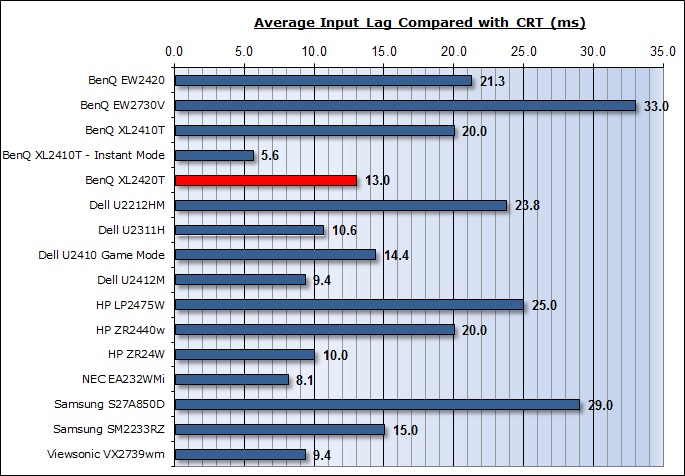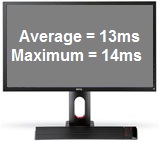|
|
||||
|
||||
|
|
We tested this ourselves and found that out of the box the screen used 31.3W of power while at its default 100% brightness setting. After calibration, where we had adjusted the brightness control to 5% and therefore the backlight intensity, this was reduced to 16.7W. In standby the screen uses only 0.7W of power. We have plotted the results of these measurements on the graph below:
The BenQ XL2420T utilises an AU Optronics M24HW01 V8 TN Film panel which is capable of producing 16.7 million colours. This is achieved through 6-bits per sub-pixel and Hi-Frame Rate Control (H-FRC) techniques. The XL2420T uses White-LED (W-LED) backlighting and so the colour space of this screen is approximately equal to the sRGB reference and is considered a 'standard gamut' backlight type. A wide gamut screen would need to be considered by those wanting to work outside of the sRGB colour space of course. It should be noted as well that this module is 120Hz compatible and can deliver 120Hz refresh rates as well as support for 3D stereoscopic content.
PWM Flicker Tests at Various
Backlight Brightness Settings
We tested the screen to establish the methods used to control backlight dimming. Our recent article talks in more details about a common method used for this which is called Pulse Width Modulation (PWM). A series of photos was taken using the method outlined in the article. These were taken at 100%, 50% and 0% brightness. This allows us to establish 1) whether PWM is being used to control the backlight, 2) the frequency at which this operates, and 3) whether a flicker may be introduced or potentially noticeable at certain settings. A thin white line was shown on an all-black background and a photograph was taken at a slow shutter speed of 1/8 second as the camera was scanned left to right in front of the screen. This produces a series of white lines which can be used to identify the frequency of the PWM and how quickly the backlight is cycled on and off. The higher this frequency, the less likely you are to see artefacts and flicker. The duty cycle (the time for which the backlight is on) is also important and the shorter the duty cycle, the more potential there is that you may see flicker. Please remember that not every user would notice a flicker from the backlight but it is something to be wary of. It is also a hard thing to quantify as it is very subjective when talking about whether a user may or may not experience the side effects. We are able to at least measure the frequency of the backlight using this method and tell you whether the duty cycle is sufficiently short at certain settings that it may introduce a flicker to those sensitive to it. The BenQ XL2420T showed a cycling frequency of ~176Hz (23 lines at 1/8 second shutter speed) in the initial tests shown here. A further test at an even slower shutter speed allowed us to more accurately record the cycling frequency at approximately 180Hz. At 100% brightness there should be no flicker evident as the backlight is not cycled on and off using PWM. At lower settings PWM is used and the duty cycle becomes progressively shorter. Given the relatively low frequency of the PWM cycling compared with some other displays (e.g. PWM of 300Hz+) and the use of LED backlighting, there is a chance that flicker may be evident to some users as you lower the brightness setting as a result.
An important thing to consider for most users is how a screen will perform out of the box and with some basic manual adjustments. Since most users won't have access to hardware colorimeter tools, it is important to understand how the screen is going to perform in terms of colour accuracy for the average user. I restored my graphics card to default settings and disabled any previously active ICC profiles and gamma corrections. The screen was tested at default factory settings using the DVI interface, and analysed using an X-rite i1 Pro Spectrophotometer (not to be confused with the new i1 Display Pro colorimeter) combined with LaCie's Blue Eye Pro software suite. An NEC branded and customised X-rite i1 Display 2 colorimeter was also used to verify the black point and contrast ratio since the i1 Pro is less reliable at the darker end.
The out of the box performance of the XL2420T was poor in terms of accuracy. You will notice that the screen is setup in the 'FPS1' preset by default which is one of the modes aimed at fast 'first person shooter' gaming. For gaming, screens are often preferred to be bright, colourful and more vivid as opposed to truly accurate and so it is not surprising to see the default setup is not really very well suited to more general use or anything requiring a higher level of accuracy. Here the screen did feel bright (although not too severe in FPS1) and colours looked quite oversaturated and cartoony. We will test the other preset modes in a moment as well to see if they return a better setup out of the box.
The CIE diagram on the left confirms that the monitors colour gamut (black triangle) very closely matches the sRGB colour space (orange triangle). It extends a little past the sRGB space in blues and greens in this 2D view of gamut but is a little short in reds.
Default gamma was recorded at 2.5 average, leaving it 14% out from the target of 2.2. Gamma was too high in all grey tones and so grey shades didn't look right and were not well balanced. The gamma curve was particularly off in lighter grey tones where it ranged up to 2.72. White point was a bit closer to the desired level thankfully, being measured at 7018k but still leaving it too cool and 8% out from the target of 6500k. Note that we are using a Spectrophotometer to make these measurements which is not sensitive to the W-LED backlight as some colorimeter devices can be. When using a standard gamut colorimeter not designed to work with modern backlighting units like W-LED, there can be a typical deviance of 300 - 600k in the white point measurement which is why some sources may refer to a different white point in this test incorrectly.
Luminance was recorded at a high 196.6 cd/m2 which is too bright for comfortable office use, but is probably a good setting for darker games. At this high ~197 cd/m2 luminance, the black depth was 0.38 cd/m2. This gave us a low static contrast ratio of 517:1. Don't be alarmed by this contrast ratio though, there is an explanation which we will look at in a moment and a way to achieve a better contrast ratio in other preset modes.
Colour accuracy was very poor at default factory settings with an average DeltaE (dE) of 5.4, ranging up to a maximum of 12.0. You will need to make a lot of adjustments if you want to use this screen for day to day normal PC use or anything which involves more accuracy. For multimedia and gaming, it is probably fine but some changes to the OSD menu controls might help bring more balance in some areas. Proper profiling with a calibration tool is preferred of course for PC use to correct the remaining errors.
We also wanted to test the screen in some of the other preset modes out of the box to see what kind of performance they returned.
We reverted to the 'sRGB' preset mode here to test the screen. Not a lot had changed really to be honest although the screen did look a little less vivid and oversaturated, and a little more realistic to the naked eye.
Gamma was actually a little worse on average at 2.6 (20% out), and colour temperature remained basically the same at 7044k (8% out). Here the luminance was higher than the FPS1 mode though at 234 cd/m2, even though actually in this preset mode the brightness control was set at 90%, instead of 100% in the FPS1 mode defaults.
The reason for this is that in the FPS1 (and FPS 2 in fact) modes there has been an adjustment made to the digital white and black levels in the factory settings for some reason. This has had the effect of reducing the maximum luminance quite significantly (to around 197 cd/m2) and also impacting the static contrast ratio (517:1). In fact in this sRGB preset, where the digital white/black level adjustments don't appear to have been made, the black depth was also much lower at 0.26 cd/m2 and contrast ratio was recorded at a much better 913:1. I assumed initially that this might be related to the 'Black eQualizer' control which is available in the OSD menu, but was only active during the FPS1 mode and not here in sRGB. Perhaps this was controlling digital white/black levels and was impacting maximum luminance and contrast ratio? However, after testing this made no impact to the contrast ratio or luminance in the FPS1 preset. This was odd and begged the question why this factory change had been made and max luminance was being restricted, while also crushing the contrast ratio? This seemed odd for a gaming mode, but at least if you revert to another preset like sRGB you can achieve a much higher contrast ratio which is respectable for a TN Film panel. The crushing of the contrast also occurred in the movie, photo, FPS2, RTS and Gamer 1/2/3 modes. In fact we only achieved a decent contrast ratio when in the sRGB, standard or ECO preset modes.
Colour accuracy was unfortunately not improved much here either. There was a better balance to the colours and they felt a little more realistic and less cartoony. Average dE was still high at 5.1 and with a maximum dE of 9.5 this was still not really suitable for any colour critical work.
We also followed the same tests in the 'standard' preset mode:
When switching to the 'standard' mode, a couple of other options became available in the OSD menu. These included control over gamma and colour temperature. Some of the other 'gaming' type features like dynamic contrast ratio and Black eQualizer were not available however. This mode felt very similar to the sRGB preset to the naked eye although it was initially quite a lot brighter. The OSD brightness control was now set at 100% by default which returned a luminance of 346 cd/m2 and a black depth of 0.38 cd/m2. Thankfully like the sRGB mode the contrast ratio was high here at 927:1.
Gamma was still a long way off from our target of 2.2 with an average of 2.6 measured (20% deviance). As with the other presets the maximum deviance was in the lighter grey shades where gamma ranged up to 2.78.
White point was pretty much the same as it had been in other modes, straying only slightly further away at 7178k (10% out now). Colour accuracy was not improved any further either and dE was still 5.2 average and 9.5 maximum. It seemed than none of these preset modes really offered a very accurate starting point and some form of calibration would be required to correct the discrepancies. This standard mode did at least offer a much better contrast ratio than the default FPS1 mode, and allowed you access to a further range of hardware settings in the OSD which should help during calibration and profiling. In fact if you also change to the 'user mode' colour temperature setting you can control the individual RGB channels for colour adjustment.
When in the 'standard' preset mode we had access to controls over the gamma and colour temperature which was useful. We first of all tested the average gamma and deviance from a target of 2.2 in each setting:
The gamma mode 1 was actually the closest to the target of 2.2 here (mode 3 is the factory default), with a 7% deviance. In fact switching to this mode had another pleasant side-effect, which was that the colour accuracy was also improved:
The gamma mode 1 had returned us a better average gamma nearer to 2.2, and also improved colour accuracy. dE was now 3.3 average and 6.6 maximum which was much better. When testing the other gamma modes, the gamma was progressively further and further away from the desired 2.2 setting, and with it the colour accuracy got worse each time. Gamma mode 1 certainly seemed to be the optimum starting point for any calibration and also helped improve the out of the box performance quite a lot as well.
There are also options in the OSD menu for colour temperature. Here they are described in words as opposed to being listed with a target temperature. They are designed to make the screen cooler or warmer at some undefined value. As a reminder we are using an i1 Pro spectrophotometer device here which can accurately read the colour temperature of the W-LED backlighting. We measured the colour temperature of the screen in each of the preset modes. All other settings were left at factory defaults (gamma was returned to mode 3 here) and no ICC profile was active. The results are recorded below:
As you can see, the normal setting had returned us a white point of 7178k. The bluish mode made the image cooler and colour temperature was now recorded at 8789k. Reddish made the image warmer and was measured at 6130k. The 'user mode' allowed you to control the individual RGB levels if you wanted to, although here we left them at 100% each. This mode had a colour temperature of 6360k which was a bit closer to our target 6500k than the 'normal' mode had achieved. Switching to the 'user mode' would again help improve default setup before profiling.
I wanted to calibrate and profile the screen to determine what was possible with optimum settings and profiling. I used the X-rite i1 Pro spectrophotometer combined with the LaCie Blue Eye Pro software package to achieve these results and reports. An NEC branded and customised X-rite i1 Display 2 was used to validate the black depth and contrast ratios due to lower end limitations of the i1 Pro device.
I first of all changed some of the settings which we had already discovered returned us a better default setup. I reverted to the 'standard' preset mode which allowed me access to further controls. Gamma was set at 1 since this had already proven to be closest to our 2.2 target and also had the nice side effect of returning the most accurate default colours. We also switched to the 'user mode' colour temperature setting which had been closer to the 6500k target. This would also allow us to control the RGB channels during the calibration process which affords us even more control over the hardware itself. This would allow us to obtain an optimum hardware starting point and setup before software level changes would be made at the graphics card level. This helps to ensure tonal values are retained as much as possible.
Adjustments were made during the process to the brightness control and to the RGB channels as shown in the table above. After this I let the software carry out the LUT adjustments at a graphics card level and create an ICC profile. The screen does not feature a hardware LUT calibration option so other than the OSD alterations, the rest of the process is carried out at a graphics card level in profiling the screen.
The calibration was a success. The gamma discrepancy that we saw before in gamma mode 1 (2.4 average, 7% deviance) had been almost completely corrected now to leave us with 0% deviance and an average gamma of 2.2. There was still some slight discrepancy with the gamma curve as you can see from the table above, but it was much smaller than before. White point was also corrected to 6510k, bringing it pretty much spot on to the target. Luminance had been reduced to a more comfortable 120 cd/m2 after the adjustment of the OSD brightness control to 5%. Black depth was still very good at 0.14 cd/m2 and this gave us a decent calibrated static contrast ratio of 839:1. Colour accuracy was also improved very nicely with dE average now only 0.7 and maximum only 1.5. LaCie would consider colour fidelity to be excellent overall.
Testing the screen with various colour gradients showed smooth transitions with only some very slight gradation in darker tones being evident. There was also some very slight temporal noise evident, particularly in darker tones if you look very closely. This is a result of the FRC algorithm used to produce the 16.7 million colour palette. It's not something you'd notice in practice, and you do have to look very closely to see it.
You can use our settings and try our calibrated ICC profile if you wish, which are available in our ICC profile database. Keep in mind that results will vary from one screen to another and from one computer / graphics card to another.
Calibration Performance Comparisons
I've provided a comparison above of the XL2420T against some of the other screens we have tested in a similar size range. Out of the box average dE was 5.4 which was poor. We have already established that the default FPS 1 mode is aimed at gaming uses and it not set up for accuracy. It is possible to improve the accuracy of the screen by making some OSD changes which we explained in our earlier sections.
The default colour accuracy of the screen was comparable to the older XL2410T model however (6.3) which was also poor out of the box. The new screen fell behind many of the modern IPS + W-LED screens we have tested including the Dell U2312HM (2.2), NEC EA232WMi (2.4) and Asus ML239H (2.3) for instance. The professional grade 23" NEC PA231W was better still at 1.6 dE average. Some form of software profiling using a colorimeter would of course be beneficial to correct some of the colours.
Once calibrated the dE average was reduced to 0.7. This would be classified as excellent colour fidelity by LaCie. It was not quite as low as some of the other screens here which reached down to 0.2 average, but purely based on this measurement there is not really any significant difference here. However, in practice you do need to keep in mind that the XL2420T is a TN Film based model and so behaves differently to many of these other screens listed which are based on IPS panels largely. TN Film models have more restrictive viewing angles, and so changes in colour tone and contrast can be caused by changes to your line of sight. We will talk about this a little later on in the review but it's important to understand that it's not all down to a single dE value measurement.
Some of the professional range models from NEC are even more accurate still than a 'regular' IPS panel. Professional grade monitors like the NEC PA series and P241W also offer other high end features which separate them from some of these other models, including extended internal processing, 3D LUT's and hardware calibration. These comparisons are based on a small selection of tests, so it should be remembered that other factors do come into play when you start talking about professional use. For further information and tests of a high end professional grade screen with hardware LUT calibration, you may want to have a read of our NEC SpectraView Reference 271 review.
The black depth and contrast ratio of the XL2420T were
very good. Calibrated black depth was 0.14
cd/m2 which
left us with a calibrated static contrast ratio of 839:1. These figures were
taken from the 'standard' calibrated preset mode since it did not crush the
contrast as we had seen from many of the other presets. The 839:1 calibrated CR
here was a little behind the previous XL2410T model, but was still very good
really. It out-performed many of the IPS based models as well. However
the modern AMVA and cPVA based models (BenQ
EW2420, Samsung F2380, NEC EX231Wp, BenQ EW2730V) offered some fantastic
contrast ratios of up to ~3000:1 which TN Film cannot compete with at the
moment. For the full reviews of the models compared here and the dates they were written (and when screens were approximately released to the market), please see our full reviews index.
I wanted to see how much variance there was in the screens contrast as we adjusted the monitor setting for brightness. In theory, brightness and contrast are two independent parameters, and good contrast is a requirement regardless of the brightness adjustment. Unfortunately, such is not always the case in practice. We recorded the screens luminance and black depth at various OSD brightness settings, and calculated the contrast ratio from there. Graphics card settings were left at default with no ICC profile or calibration active. Tests were made using an NEC branded and customised X-rite i1 Display 2 colorimeter. It should be noted that we used the BasICColor calibration software here to record these, and so luminance at default settings may vary a little from the LaCie Blue Eye Pro report. These tests were conducted in the 'Standard' preset mode as we had already discovered that contrast was not crushed like it was in some of the gaming presets.
The luminance range of the screen was wide with an overall adjustment range of 219.5 cd/m2. At the top end, the 100% brightness control returned us a luminance of 346.1 cd/m2 which was almost spot on to the maximum specified figure for the screen of 350 cd/m2. The OSD menu brightness control allowed you to adjust this all the way down to 126.6 cd/m2 in this 'standard' preset which was ok. However, without a further adjustment range possible from the backlight, users wanting to use the screen at darker settings or in darker working environments may struggle a bit. In some of the other preset modes you could reach lower luminance settings but it was at the cost of contrast ratio and achieved seemingly through adjustments at a digital white/black level. In the standard mode, a setting of 0% is needed really in order to return you a luminance of close to 120 cd/m2 at default settings. Black point ranged from 0.38 to 0.14 cd/m2 which was pretty decent for a TN Film panel.
We have plotted the luminance trend on the graph above. The screen behaves as it should, with a reduction in the backlight intensity controlled by the reduction in the OSD brightness setting.
Static contrast ratio remained stable across the range, with an average figure of 913:1. It was a little less stable at the lower end of the brightness range below a setting of ~40%. These contrast measurements were plotted on the graph shown above.
The BenQ XL2420T features a dynamic contrast ratio (DCR) control, which boasts a spec of 12,000,000:1 (12 million:1). Dynamic contrast ratio involves controlling the backlight of the screen automatically, depending on the content shown on the screen. In bright images, the backlight is increased, and in darker images, it is decreased. We have come to learn that DCR figures are greatly exaggerated and what is useable in reality is often very different to what is written on paper or on a manufacturers website. For this test I would use the colorimeter to record the luminance and black depths at the two extremes. Max brightness would be recorded on an almost all white screen. Black depth would be recorded on an almost all black screen. In real use you are very unlikely to ever see a full black or full white screen, and even our tests are an extreme case to be honest. Carrying out the tests in this way does give you a good indication of the screens dynamic contrast ratio in real life situations however.
Unlike a lot of screens we have tested recently, this DCR did seem to function a little bit which was good. You can see the transitions with the naked eye but they are in very small steps and are slow. The DCR has a setting from 1 to 5 which controls the intensity and speed of the technology, with 5 being the most "aggressive". Even in mode 5, the transitions were very slow and subtle. When you enable the technology the brightness and contrast settings become locked and greyed out. We did manage to achieve a DCR of ~2411:1 which was ok (in the 'movie' preset by the way), but obviously nowhere near the specified maximum DCR of 12 million:1. This was based on measurements of an almost completely white and almost completely black screen which we normally carry out. In a further test we also tried displaying a 100% all black screen. This did actually result in the backlight being turned down even further, to the point where it looks almost as if it is completely turned off. In fact it is not being turned off completely as moving the mouse reveals a very dark grey pointer. It does however reach below 0.02 cd/m2 which is beyond the limits of the X-rite i1 Display 2 colorimeter being used. This means the screen can offer a DCR of over 8400:1, but due to limitations with the measurement device, we cannot give an exact figure. So if you were to view a 100% black image, the DCR feature is capable of reducing the black point even further. Given the speed it takes to change between maximum and minimum brightness is about 20 seconds, it is unlikely you would ever see the real range of the DCR feature in normal use. You would probably never see a 100% black image in normal applications anyway, and even if you did it would also never be displayed long enough for the DCR to reach its maximum range. For the purposes of this test the more useable DCR would be ~2411:1. The changes are slow and so the transitions during actual gaming or movies are quite subtle at least. It is not so rapid that it is obvious that it is constantly changing brightness on the fly, but you need to remain in a light or dark scene for quite some time before it can properly catch up.
Viewing angles of the XL2420T were as you might expect from a TN Film panel. Unfortunately this panel technology is inherently poor in this field, and so viewing angles are far more restrictive than other competing technologies like IPS, PLS and VA. Although the manufacturer will quote a viewing angle of 170 / 160 (a classic indication that a TN Film panel is being used by the way if in doubt), in practice there are some obvious contrast and colour tone shifts both horizontally and vertically. As you move your head from side to side in a horizontal plane, there is a contrast shift and the image becomes lighter. As you move to a wider angle the image can become darker and a yellow and silver colour tint is introduced as you can see from the above photos. Vertically the fields of view are more restrictive still. From above the image becomes pale and washed out, while from below there is a characteristic TN Film darkening of the image. Unfortunately vertically the viewing angles will introduce noticeable shifts in the contrast and colour tone of the image which mean that for any colour critical work it is not really very well suited. TN Film panels have long suffered from these restrictive viewing angles due to the nature of their pixel structure. They are still fine for a single user for general use and certainly the TN Film panels offer their advantages when it comes to pixel response times and gaming. If however, you were hoping to do any colour critical or photography work you may find these shifts in the appearance of the image difficult. An IPS panel would probably be a wiser choice if you were looking for a screen with much wider viewing angles but having said that you are probably mainly interested in gaming if you are considering this screen.
On a black image there is a slight pale silvery tint introduced to the image when viewed from a wide angle. This isn't too severe and shouldn't present any real problems in practice. Measurements of the screens luminance were taken at 35 points across the panel on a pure white background. The measurements were taken using BasICColor's calibration software package, combined with the NEC customised X-rite i1 Display 2 colorimeter. The above uniformity diagram shows the difference, as a percentage, between the luminance recorded at each point on the screen, as compared with the reference point of a calibrated 120 cd/m2 in the centre of the screen. This is the desired level of luminance for an LCD screen in normal lighting conditions, and the below shows the variance in the luminance across the screen compared with this point. It is worth noting that panel uniformity can vary from one screen to another, and can depend on manufacturing lines, screen transport and other local factors. This is only a guide of the uniformity of the sample screen we have for review.
Uniformity of Luminance The luminance uniformity of the XL2420T was unfortunately not great. There was a fairly large deviance in luminance recorded between the centre and the right/left hand edges of the panel. In fact, this variance was as much as 35% along the left hand edge, where the luminance dropped down to 87 cd/m2 as compared with the centre of the screen at a calibrated 120 cd/m2. The right hand edge was not quite as variable, but did drop down by ~27% to 93 cd/m2 in the upper right hand corner. Unfortunately there seemed to be a fairly poor luminance uniformity from our sample and it was a fairly similar pattern to that which we'd seen from the XL2410T before.
As usual we also tested the screen with an all black image and in a darkened room. A camera was used to capture the result. There was no noticeable backlight leakage or bleeding from this sample which was excellent. This is positive news as being a gamers screen, there's a good chance people will want to use the screen in darkened room conditions and any leakage could have been very obvious and distracting.
The BenQ XL2420T offers an adequate solution for general office and internet applications. The 1920 x 1080 resolution and 24" screen size offer a good screen real estate to work with, and side by side splitting of the screen is perfectly useable. The slightly reduced vertical resolution (1080 pixels) compared with a 16:10 format screen (1200 pixels vertically) means you do lose a bit of height however. I personally prefer a 1920 x 1200 screen for office work for this reason. The 0.276 mm pixel pitch offers a comfortable text size for day to day use, a little bigger than some of the modern ultra-high resolution models like the 2560 x 1440 res 27" models for instance. Default luminance of the screen was recorded at 197 cd/m2 which is too high for prolonged office use. You will want to turn the screen down probably as low as 0% brightness to achieve a luminance of around 120 cd/m2. Those wanting to use the screen in darker room conditions and at a luminance lower than this may struggle however, since the adjustment range of the backlight is limited at the lower end. You can achieve a lower luminance by switching to some of the other preset modes, but as explained already this is at the cost of contrast unfortunately. There are no specific 'text' or 'internet' presets available from the OSD menu, so you will probably want to calibrate the standard or sRGB modes to a lower luminance. There are such a big range of presets and customisable modes that it should be easy to set the screen up so you can quickly switch between different uses. The restrictions of TN Film come in to play a little here again since the viewing angles are not very wide. You will need to ensure you are aligned at the right angle to the screen to avoid distracting contrast and colour tone shifts. If you are hoping to use the screen for colour critical work you may want to consider whether TN Film technology is really suited to you, and look at an IPS panel instead. I tested the screen using both the analogue D-sub and digital DL-DVI interfaces. The DVI offered a slightly sharper image and better picture quality, and the D-sub was a little blurry I found. Text was still readable of course, but some clarity was lost. I would definitely recommend using the digital interface wherever possible.
The ergonomics of
the screen offered a great range of adjustments. It was good to see a full range
of height, tilt, pivot and swivel available although they were a little stiff to
use in some cases. At least you should be able to position the screen at a
comfortable setting for your individual preferences. It was also good to see
some USB ports available and even a headphone jack and hanger on the back of the
stand. There are no further extra features like
ambient light sensors and card readers which are often useful in office
environments.
The screen is designed to run at its native resolution of 1920 x 1080 and at a 120Hz recommended refresh rate. Of course for office use 60Hz has no effect on overall picture quality, although movements of the mouse and dragging around of windows will look and feel snappier and smoother in 120Hz mode. If you want you are able to run the screen outside of this resolution of course. We tested the screen at a lower 1600 x900 resolution while maintaining the same aspect ratio (16:9) to see how the screen handles the interpolation of the resolution. At native resolution the text was very sharp as you can see from the top photograph. When you switch to a lower resolution the text is more blurry. There was fairly low levels of overlap of the pixels and text was still reasonably readable. Native resolution is recommended where possible of course.
Like the BenQ XL2410T before it, the XL2420T is a screen designed by gamers, for gamers. While it might be used for other uses from time to time, the screen is primarily targeted at those wanting to play fast moving games and first person shooters. The screen was designed with input from five well-known Counter Strike players and has a whole range of features which should make this a good option for the hardcore gamers out there. As BenQ put it, "gaming is in the details".
BenQ's website states: "The task of conceptualizing the XL2420T as the ultimate gaming monitor involved a unique collaboration with prominent pro gamers: Tommy “Potti” Ingemarsson, Emil “HeatoN” Christensen, Abdisamad “SpawN” Mohamed, Michael “ahl” Korduner and Christer “fisker” Eriksson. These five names alone are synonymous when it comes to legendary Counter-Strike players. Their accumulated wealth of knowledge and skills helped BenQ develop a monitor that adapts to the needs of gamers to improve their chances of winning."
Before we get in to the get into the side by side screen comparisons I want to quickly talk about the overdrive control available through the screens OSD menu. It is available within the 'picture' section under the 'AMA' (Advanced Motion Accelerator) option as shown above. This allows you to manually control the overdrive / RTC impulse being applied to the pixels, with a setting of on and off available. Overdrive is designed to help improve pixel responsiveness and reduce motion blur and ghosting in practice by speeding up the transitions the pixels make to change from one colour to another. You may wish to read our specs section for some further information about overdrive / response time compensation.
The screen was tested using the chase test in PixPerAn, a good bit of software for trying to quantify differences in real terms responsiveness between monitors. As a reminder, a series of pictures are taken on the highest shutter speed and compared. The images above are the best case examples from the screen with the AMA function off and then on. In these instances I ran the screen at a normal 60Hz refresh rate. The XL2420T can of course support higher refresh rates up to 120Hz which we will test in a moment. With AMA disabled at 60Hz you could notice a fairly obvious blur and ghosting image behind the moving car. It was not too severe, and certainly not as blurred as some non-overdriven IPS and VA panels we have seen, but it was certainly there. When turning AMA off you are removing the overdrive impulse which is being applied to the pixels. The grey to grey transitions are not boosted by the overdrive impulse and so the panel behaves a lot more like a normal 5ms rated TN Film panel which does not feature any overdrive circuit. When AMA is activated there is a noticeable improvement in the clarity of the image to the naked eye, and captured by the camera here as well. A large amount of the motion blur is removed and the image looks sharper. However, because of the aggressive overdrive impulse, there are some artefacts created, which are caused by overshoot of the overdrive. This has led to the introduction of some dark and pale trails behind the moving car which you can pick out with the naked eye if you look closely. They aren't too obvious, and I would say that the improvement in responsiveness and reduction in blurring is worth the slight overshoot.
One of the main selling points of the XL2420T for gamers is its support of a true 120Hz refresh rate. This is not an interpolated refresh rate like many modern LCD TV's, but the screen can support a genuine 120Hz refresh rate input from the graphics card. As a result you are able to achieve higher refresh rates in games, with higher frame rates. It can also have an impact on the overall responsiveness and feel of the panel for gaming which we will look at in a moment. BenQ's website states: "With a refresh rate of 120Hz, there’s never a lag and every in-game details will be smoothly rendered. Drawing on hyper-speed video processing technology, the XL2420T gives you on-screen action and captivating realism."
You can simply select 120Hz refresh rate from your display settings as shown above. Even in Windows, the movement feels faster and smoother and dragging around text boxes and browser windows feels snappier. Of course one of the main reasons for wanting this 120Hz support is that the screen can then give you a higher frame rate of 120 frames per second (fps) as opposed to the 60fps when using 60Hz (with vsync). Any serious gamer will tell you that frame rates are very important for fast action and so here's a screen which can support double the frame rate of many LCD panels. With 120Hz support, the screen is also able to handle 3D stereoscopic content using an NVIDIA graphics card and their active 3D glasses and games.
We repeated the same PixPerAn tests, this time while using a 120Hz refresh rate. You could immediately spot the smoother feel to the movement even in this basic test, and the higher refresh rate and frame rate helped improve the feel of the panel. You will notice here that even with AMA turned off, there were some significant improvements compared with running in 60Hz mode. A large amount of the blurring had been removed now, even though the AMA overdrive impulse was not being applied. It's important to realise a few things here in relation to 120Hz mode. Firstly, the extra 60Hz does not alter the response time of the panel, since the operation of the pixels and their electronics remains unchanged. The AMA feature is there to allow you to control whether the overdrive is applied or not. The improvement in the performance and reduction in motion blur is actually related to the frame rate of the screen, which sends a new image to the display at twice the frequency of before. As the image moves across the screen, it generates a blur and ghosting trail behind it. The next frame sent to the display causes the image to update and the pixels change again. In 120Hz mode, the time between each frame being sent is half that of at 60Hz (i.e. twice as many frames per second). As a result, the trailing image is reduced by half, and the moving image is refreshed at twice the speed. In practice this eliminates a large amount of the motion blur and ghosting which is visible at 60Hz. If you then enable the AMA function there is a slight improvement to the sharpness of the moving image which you can spot with the naked eye if you look closely. It helps remove the small amount of blurring left. However, the overshoot artefacts are re-introduced again, but those two are now noticeably less than they had been in 60Hz mode. The dark and pale trails are still there if you look very closely, but they are reduced and less obtrusive.
We have provided all four of these tests above to give you an easier comparison between the four possible states. You will notice that the 120Hz mode does significantly reduce the motion blur and overshoot compared with 60Hz. Obviously if you've invested in a screen like this, you are presumably going to want to use the 120Hz refresh rate to improve your gaming experience and frame rates anyway. I would certainly recommend it from a pixel response time point of view as well. When in 120Hz mode, the screen performs very well regardless of whether you have AMA active or not in these tests. Enabling this feature does help provide a slightly sharper image and reduce the remaining slight blur which is good and for other pixel transitions and in general gaming it helps to improve the quality of the image. The resulting overshoot from enabling AMA is not too severe which is positive news.
|
|||||||||||||||||||||||||||||||||||||||||||||||||||||||||||||||||||||||||||||||||||||||||||||||||||||||||||||||||||||||||||||||||||||||||||||||||||||||||||||||||||||||||||||||||||||||||||||||||||||||||||||||||||||||||||||||||||||||||||||||||||||||||||||||||||||||||||||||||||||||||||||||||||||||||||||||||||||||||||||||||||||||||||||||||||||||||||||||||||||||||||||
|
|
|
Class 1 |
On to our tests then in their new format using SMTT 2.0. We have provided a comparison above against other models we have tested to give an indication between screens. However, please note that many of the other screens tested here were using older stopwatch methods and not the SMTT 2.0 tool. For instance it is probably unfair to directly compare the XL2420T with the XL2410T here, but I have left it in for those interested.
The input lag of the XL2420T actually seemed to be identical when instant mode was enabled and disabled. I carried out a number of tests with different aspect ratios, with AMA turned on and off and in 60Hz and 120Hz modes. It seemed to have no impact at all to the overall image lag from our tests and in both cases the lag was a very low 13ms average. Remember that this overall lag takes into account the signal processing delay as well as the response times of the pixel transitions. It seems that the actual signal processing lag is very low in both cases and there is probably not much for the instant mode to bypass.
We have classified the XL2420T as Class 1,
with a low level of input lag which should be fine for even fast FPS gaming.
This is what you would of course have hoped for from a gamer orientated screen.
|
|
For more information about the
SMTT 2.0 tool, or to purchase a copy please visit: |

The following summarises the screens performance in video applications:
-
24" screen size makes it a reasonable option for an all-in-one multimedia screen, although quite a bit smaller than modern LCD TV's of course
-
16:9 aspect ratio is more well suited to videos than a 16:10 format screen, leaving smaller borders on DVD's and wide screen content.
-
1920 x 1080 resolution can support true 1080 HD resolution content
-
Digital interfaces including DVI, HDMI and DisplayPort support HDCP for any encrypted and protected content
-
Additional DisplayPort and 2x HDMI interfaces are available which are very useful for external Blu-ray / DVD player connectivity.
-
Black depth and contrast ratio are good in certain preset modes (don't use the 'movie' preset). Detail in darker scenes and shadow detail should not be lost due to these measurements.
-
Dynamic contrast ratio is available but is pretty slow and only works to a small degree. It should allow a DCR up to about 2411:1 however for those who like this technology.
-
'Movie' preset mode is available which seems to accentuate the sharpness and colours and make everything look more vivid. However, the colours are not as accurate and contrast ratio is crushed to around 500:1 unfortunately.
-
Excellent pixel responsiveness which should be able to handle fast moving scenes in movies without issue
-
Viewing angles are restrictive unfortunately, due to the use of TN Film panel technology. Contrast shifts are pretty obvious and may prove a problem if you're trying to watch the screen from different angles or with other people.
-
Good ergonomic adjustments available from the stand allowing you to obtain a comfortable position for movie viewing potentially. Viewing angles mean that it is probably only possible to align comfortably for one user.
-
No backlight leakage from the panel which was pleasing. Thankfully no leakage along any of the edges which has the potential to become distracting when watching movies, especially where black borders are present.
-
No integrated stereo speakers on this model but there is a headphone jack if you want to use it
-
No picture in picture (PiP) or picture by picture (PbP) modes available on this model.
-
For PAL sources, we have tested the screen and confirmed it will support the full native resolution of 1920 x 1080 at 50Hz refresh rate.
-
The Smart Focus option available in the OSD menu gives you a way to highlight a particular part of the image you are looking at and darken the rest of the screen. You can change the size and position of this 'window' which may be useful for watching movies embedded in websites, or sites like YouTube.
|
This review had been made available to download and save in PDF format (.pdf) allowing you to:
Please visit our Store for more information and to download a copy. A small fee will contribute towards the running of TFTCentral and allow us to continue to make high quality and detailed reviews in the future. |
The BenQ XL2420T was a very interesting screen to test, and quite a nice variation from some of the modern IPS, VA and PLS panels we have tested of late. Clearly the XL2420T is primarily aimed at gamers and I expect you wouldn't be looking at a screen like this for any other uses on the most part.
In some regards the screen was a little disappointing. The default set up of all of the presets was poor, although a few simple changes in the standard mode did help a lot. We perhaps can't moan too much about this as the setup is probably more aimed at gaming anyway, with vivid, bright colours and less focus on real accuracy. What was a bit odd was the apparent factory adjustment to the digital white/black levels in most of the presets which crushed blacks and contrast ratio quite significantly. In some modes though you could achieve a good contrast ratio of ~900:1, and at least with some calibration and profiling you could quite easily get the screen looking more accurate for other uses. Of course then the screen is most limited by the use of TN Film panel technology, with restrictive viewing angles playing their part in picture quality in many 'normal' uses. The adjustment range of the backlight in some modes was also a little limited at the lower end and panel uniformity was not great. At least there was no noticeable backlight leakage which was good news.
Where the XL2420T does do very well is in it's functions, features and performance relating to high end gaming. Here the use of a TN Film panel is an obvious advantage, with its inherent speed being a positive. There was a mass of options and presets available to allow you to set up the screen as you would like, or even use some of the preset FPS or RTS modes defined by BenQ. The ability to download and activate additional presets being used by the professionals was also a nice touch, and the provided S Switch device was useful for switching between your saved 'gamer' presets quickly and easily. The carry handle, headphone clip and protective plastic cover were all nice extras and should be useful when transporting your screen to competitions or LAN parties. The Black eQualizer feature was also pretty good at bringing out details in darker scenes through the adjustment of the gamma in dark tones. You can even make this available as a quick access from the OSD menu if you want to regularly change the setting. The wealth of aspect ratio options was also comprehensive and should cover all your needs.
Of course some of the biggest attractions to this screen are the ultra-low response time and support of 120Hz refresh rates. Pixel responsiveness was very good, with the AMA function helping to boost transitions and reduce motion blur well. The obvious dark overshoot which plagued the XL2410T predecessor has largely been removed which was great news, and the responsiveness is improved a step further when 120Hz mode is in use. The 120Hz refresh rate then also gives you support of 120 fps frame rates and provides a smoother, snappier feel to the screen for gaming and generally in day to day use. This will of course also support 3D content through active shutter methods which is good news for those wanting to game in 3D as well. Input lag was also very low which should mean no real issues with the screen in competitive gaming situations.
The XL2420T has made some nice improvements over
its predecessor for sure, with far more connectivity choices, more OSD options,
features like Black eQualizer and downloadable presets, and ultimately
improvements in the gaming performance through optimisation of the AMA overdrive
feature and updates like NVIDIA's LightBoost technology. The XL2420T retails for
~£300 GBP (inc VAT), while the XL2410T is still available at ~£270. This also
makes the XL2420T a little more expensive than some popular 24" IPS models like
the Dell U2412M (£250) and around £100 - 150 more than a 'normal' 60Hz TN Film
model. Having said that, there's a lot of extras here, and no expense spared
when it comes to connectivity and ergonomic adjustments. This would be well
worth a look if you want a high end gaming screen for sure.
|
Pros |
Cons |
|
Ultra-fast response times and 120Hz support for high frame rates and smooth motion |
Restrictions of TN Film technology apparent, particularly with viewing angles |
|
Wealth of gaming extras including Black eQualizer, comprehensive aspect ratio controls, downloadable presets, S switch |
Crushing of blacks and contrast ratio in some presets |
|
Wide range of interface connections and ergonomic adjustments |
Minimum adjustment of backlight quite high in some modes |
|
If you have enjoyed this review and found it useful, please consider making a small donation to the site. |



